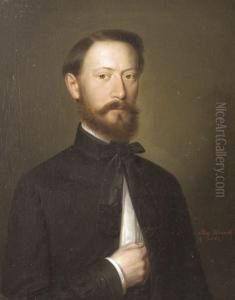Henrik Pecz Paintings
Henrik Pecz was a Hungarian architect and academic, renowned for his significant contributions to the architectural landscape of Hungary at the turn of the 20th century. Born on June 1, 1854, in Baja, Hungary, Pecz developed an interest in architecture at a young age and pursued his passion through his studies and early work.
Pecz's architectural education began at the Technical University of Budapest, followed by further studies at the Academy of Fine Arts Vienna, one of the most prestigious art schools in Europe at the time. His education was comprehensive and provided him with a solid foundation in the historical and contemporary architectural practices of the period.
After completing his studies, Pecz embarked on his professional career, which quickly gained momentum due to the burgeoning construction and architectural development in Hungary during this period. He was influenced by a variety of styles, including historicism and the emerging Art Nouveau. Pecz's work is characterized by a meticulous attention to detail, a characteristic of the academic architectural training of the era, as well as an openness to incorporating new construction technologies and materials.
One of Pecz's most significant contributions was his role in the construction of the Szeged City Hall, completed in 1883, which showcased his adeptness at blending functional public architecture with aesthetic grandeur. His work often reflected the national pride and identity that were pivotal in Hungarian architecture following the Austro-Hungarian Compromise of 1867.
In addition to his architectural practice, Pecz was also an influential academic. He held a professorship at the Technical University of Budapest, where he taught many students who would go on to become prominent figures in the field of architecture themselves. His commitment to education underscored his belief in the importance of nurturing the next generation of architects.
Henrik Pecz's career spanned a period of significant change in Hungary, both politically and culturally. He navigated this landscape with a vision that often married traditional Hungarian elements with the innovative trends of the broader European architectural context. Pecz passed away on October 6, 1922, leaving behind a legacy that continues to be celebrated in Hungarian architecture. His works remain studied and admired, both for their design excellence and for their role in the evolution of Hungarian national style in architecture.






